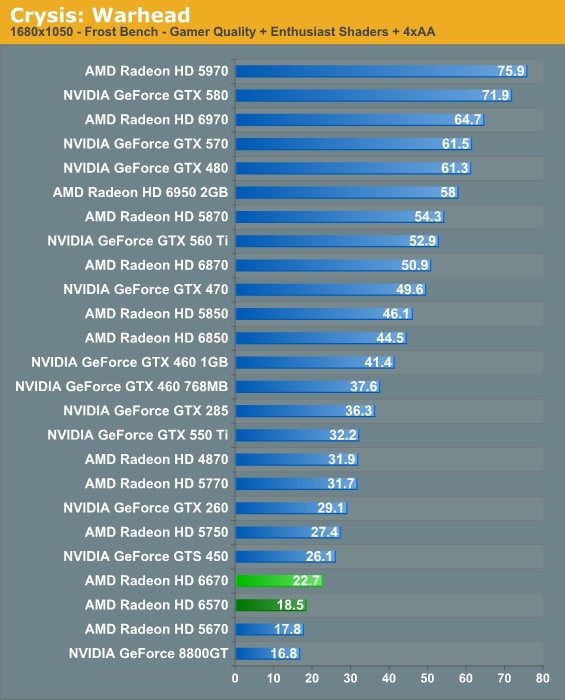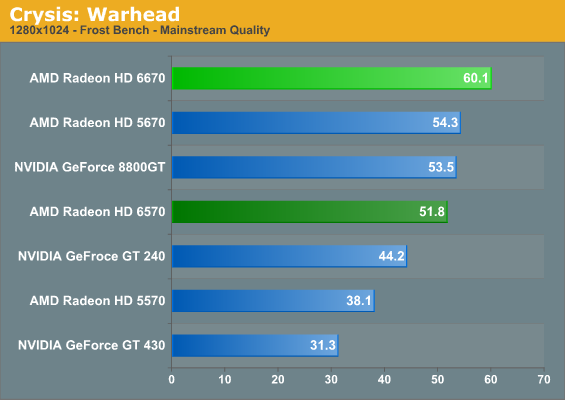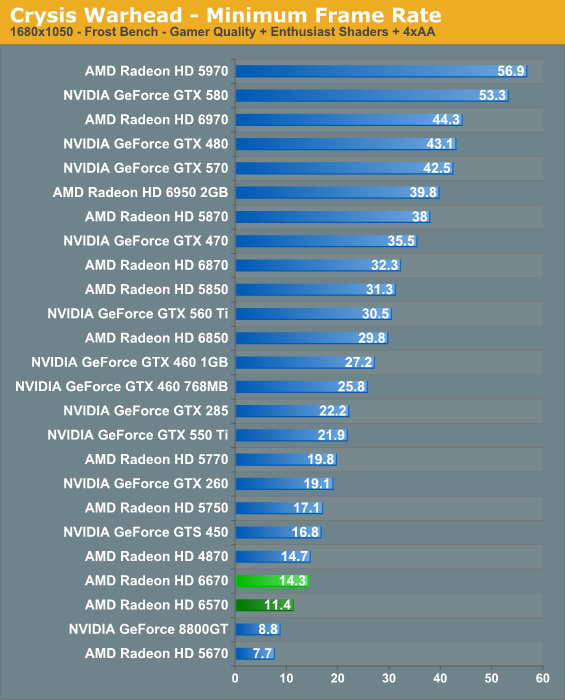AMD’s Radeon HD 6670 & Radeon HD 6570: Two’s Company, Sub-$100’s A Crowd
by Ryan Smith on April 19, 2011 12:01 AM ESTCrysis: Warhead
Kicking things off as always is Crysis: Warhead, still one of the toughest games in our benchmark suite. Even three years since the release of the original Crysis, “but can it run Crysis?” is still an important question, and for three years the answer was “no.” Dual-GPU halo cards can now play it at Enthusiast settings at high resolutions, but for low-end cards even Mainstream/Medium quality is about the best that can be achieved.


It takes a 5770 to crack 30fps in Crysis at 1680x1050, so the fact that the 6670 is only a bit over 20fps isn’t a big surprise. As far as performance at 1680 is concerned Crysis is a good summary of what we’ll see: too slow for 1680, and well behind the next tier of cards represented by the GTS 450 and the Radeon HD 5770/5750. However the 6670 does have a notable advantage here: with 1GB of VRAM it handles 1680 much better than the 512MB 5670, even if it’s ultimately too slow to be playable at these specific settings.
So for the kind of high settings we like to test at, it’s 1280 that’s going to be playable on the 6670, 6570, and similar cards. Once we drop down to 1280 and Mainstream quality the 6670 can crack 60fps, and with a bit of fiddling it should be possible to increase the quality of a setting or two without significantly impacting performance. Overall the 6670 has a 10% lead over the 5670 it replaces, which is a reasonable outcome for a game that’s largely (but not completely) shader-bound.
As for the 6570, it’s well-entrenched near the top of the pack. At 95% of the performance of the 5670 it does quite well, and the next-fastest modern card is the GT 240 which is quite some distance off. Against the 5570 it has a 35% lead, thanks largely to the use of GDDR5 instead of DDR3.
We have also thrown in the 8800GT into our 1280 results, just to offer a different look at performance relative to NVIDIA’s retired champion. It’s a good reference point for where we’re at now, versus what a $300 card did 3 years ago; and once we get to power/temperature/noise testing how better process technology and smaller GPUs have improved those metrics.


Looking at the minimum framerates, the relative ranking of our cards remains unchanged. The 6670 cements its lead over the 5670 here at 1680 thanks to its 1GB of VRAM, while at 1280 the gap narrows significantly to 5%. Meanwhile the 6570 loses ground on the 5670, with the 5670 taking a 10% lead.










53 Comments
View All Comments
Taft12 - Tuesday, April 19, 2011 - link
Courtesy of Hardwarezone (and Techconnect), here's a look at what many of the major AMD video card hardware partners have for us on release day:ASUS:
http://www.hardwarezone.com/tech-news/view/166085
Gigabyte:
http://www.hardwarezone.com/tech-news/view/166139
MSI:
http://www.hardwarezone.com/tech-news/view/166128
Sapphire:
http://www.hardwarezone.com/tech-news/view/166079
HIS:
http://www.tcmagazine.com/tcm/news/hardware/37325/...
Powercolor:
http://www.tcmagazine.com/tcm/news/hardware/37324/...
Highlights (for me): the HIS fanless 6570 and that dual-fan MSI 6670! I'm sure many more overclocked and exotic cooler models (like MSI Cyclone and HIS IceQ) are on their way
LB-ID - Tuesday, April 19, 2011 - link
The eternal question.ekoostik - Thursday, April 21, 2011 - link
I just read all the comments looking for something like this. Thanks for not letting me down. Ryan, nice TMBG reference.larson0699 - Tuesday, April 19, 2011 - link
We know, we know. The article immediately reads "copypasta" when I see this. *sigh*jah1subs - Tuesday, April 19, 2011 - link
Personally, I expect my next build to be used mostly as a work (browser + Office 2010) PC (no games) and to be used sometimes as an HTPC and -- very infrequently -- a video encoder since our only child will probably be more than 500 miles away, going to college. I am cheap, especially about electricity. My apartment is all fluorescents today and I am impatiently waiting for 5000K LED bulbs.Therefore, I may be looking at the 6570, or, more likely, the 6450. But what about the Sandy Bridge integrated 3000 graphics? Below, I have copied several paragraphs about the 23.976 fps problem from The Sandy Bridge Review, "A Near-Perfect HTPC." What is the current status of the software fix mentioned in the last paragraph? Is it available? Have you tested it?
"What happens when you try to play 23.976 fps content on a display that refreshes itself 24.000 times per second? You get a repeated frame approximately every 40 seconds to synchronize the source frame rate with the display frame rate. That repeated frame appears to your eyes as judder in motion, particularly evident in scenes involving a panning camera."
"How big of an issue this is depends on the user. Some can just ignore the judder, others will attempt to smooth it out by setting their display to 60Hz, while others will be driven absolutely insane by it."
"If you fall into the latter category, your only option for resolution is to buy a discrete graphics card. Currently AMD’s Radeon HD 5000 and 6000 series GPUs correctly output a 23.976Hz refresh rate if requested. These GPUs also support bitstreaming Dolby TrueHD and DTS-HD MA, while the 6000 series supports HDMI 1.4a and stereoscopic 3D. The same is true for NVIDIA’s GeForce GT 430, which happens to be a pretty decent discrete HTPC card."
"Intel has committed to addressing the problem in the next major platform revision, which unfortunately seems to be Ivy Bridge in 2012. There is a short-term solution for HTPC users absolutely set on Sandy Bridge. Intel has a software workaround that enables 23.97Hz output. There’s still a frame rate mismatch at 23.97Hz, but it would be significantly reduced compared to the current 24.000Hz-only situation."
Anandtech, thank you in advance for your reply.
Belard - Wednesday, April 20, 2011 - link
For an office/browser setup. Any current technology will work just fine. My old 2009 ThinkPad runs Windows7 pretty good with a PDC 1.8Ghz (bottom end Core2) with crappy intel graphics and 2GB of RAM.The AMD Fusion Llano platform is pretty exciting and its not even the top-end bulldog. Its onboard graphics destroys intel and it'll help the CPU with other tasks.
Sandy bridge is very good of course, so just add a $60~80 video card and you are ready to go. Sad we have to talk about todays CPUs by their code-names.
** Don't expect an answer concerning the 23.976fps issues. Call intel on that one. intel always had and always will have sub-par graphics. Check out HOW stupid Intel is.
For the bottom end SB, it has the worst performing built-in GPU. The top-end has their best, which is still pathetic compared to the graphics built into AMD chipsets. Logic should dictate that the person who spends $500+ on a CPU, is most likely going to have a dedicated video card - DUH! Even a $40 6450 will smoke any built-in Sandybridge graphics. Its the entry level systems that need better graphics.
papapapapapapapababy - Wednesday, April 20, 2011 - link
i got 640 sp in 2009 for 99$... (4770) screw u AMD... go sell this POS to NintendoSpoelie - Wednesday, April 20, 2011 - link
Sapphire just launched an 5850 SKU ("xtreme") at sub 150$ prices...euroland: 115€
http://azerty.nl/0-970-401029/sapphire-radeon-hd-5...
newegg: 145$
http://www.newegg.com/Product/Product.aspx?Item=N8...
crazy prices for the performance
don't know how long supplies will last but it launched less than 10 days ago..
Spazweasel - Friday, April 22, 2011 - link
Has anyone actually seen a low-profile 6670 offered for sale anywhere? I see only a small handful of full-height cards when I search.Taft12 - Monday, April 25, 2011 - link
No OEM ever made a low-profile 5670 and I don't imagine there will be a low-profile 6670 either.